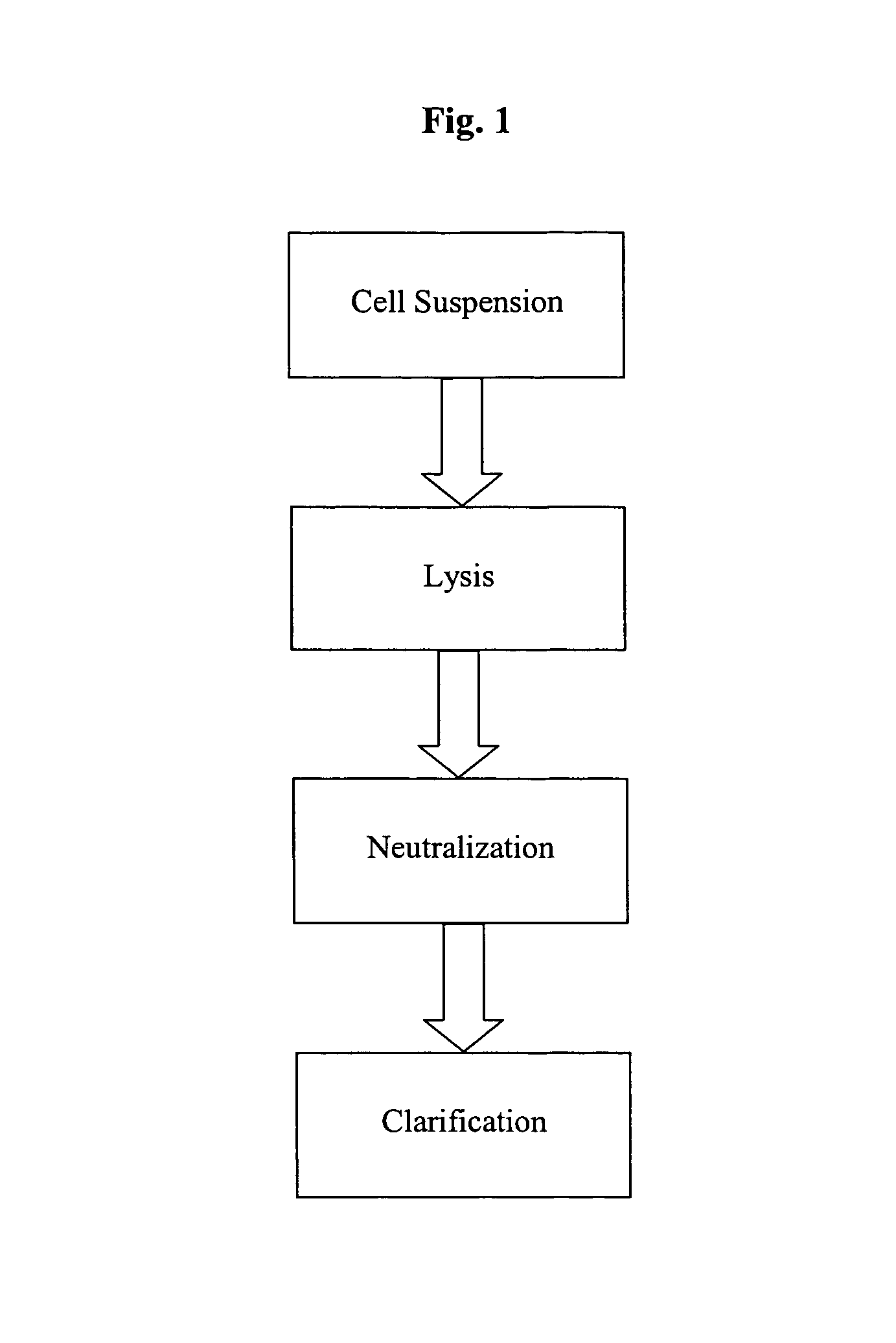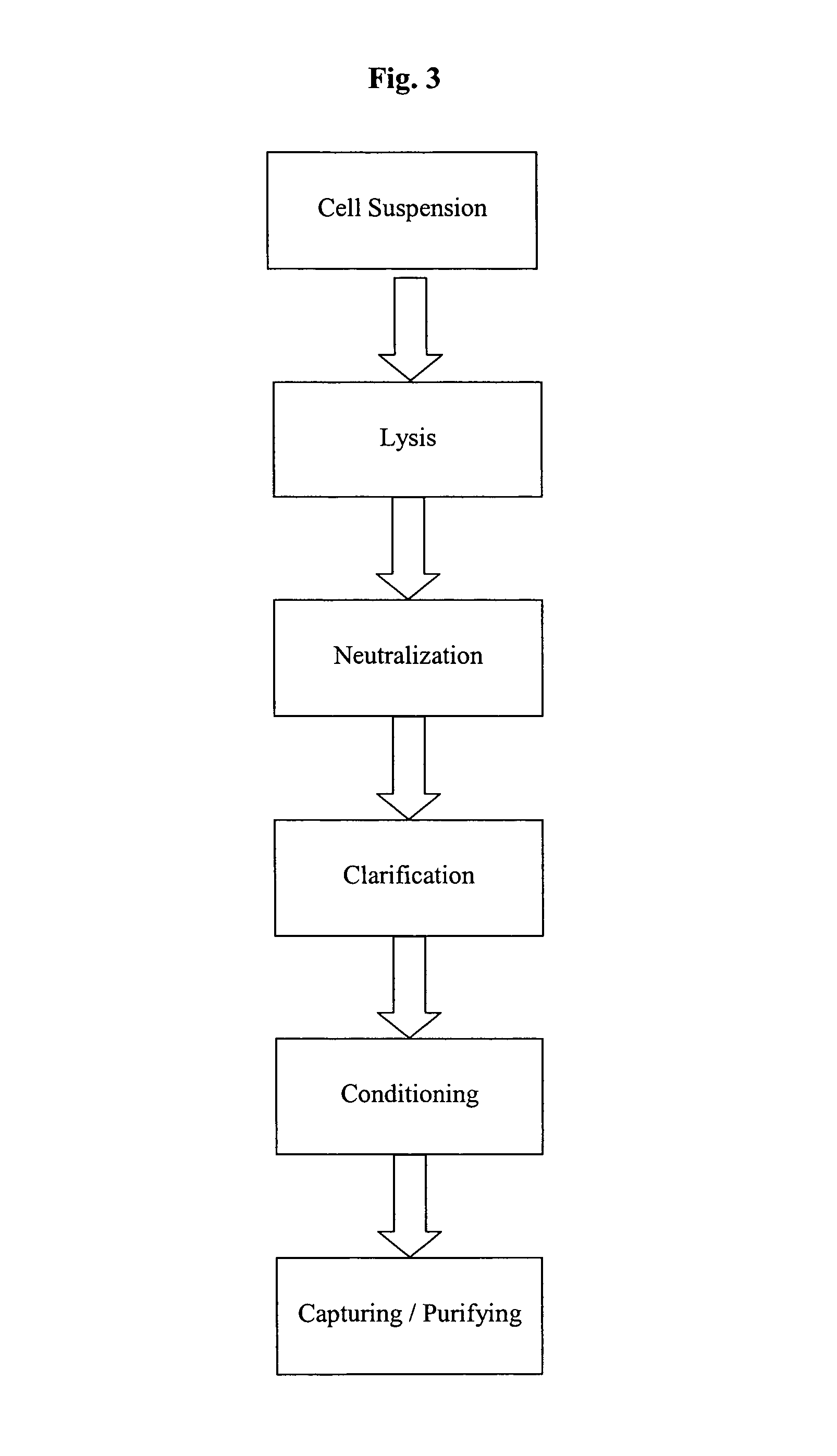Methods and devices for producing biomolecules
a biomolecule and method technology, applied in the field of polynucleotides, can solve the problems of inability to adapt the method for the production of polynucleotides, the inability to use the method for polynucleotides without certain adaptations, and the limitations of established techniques
- Summary
- Abstract
- Description
- Claims
- Application Information
AI Technical Summary
Benefits of technology
Problems solved by technology
Method used
Image
Examples
example 1
Production of pDNA-Containing E. Coli Cells
[0152]The pDNA containing E. coli biomass for the pilot scale runs was produced at 20 l or 200 l fermentation scale according to the following procedure (this description relates to the 20 l fermentation):
Pre-Culture
[0153]The working cell bank of a production strain of the plasmid pRZ-hMCP1 (Escherichia coli K12 JM108; ATTC no. 47107; plasmid size: 4892 kbp) was maintained in cryo vials (glycerol stocks) at −70° C. A cryo vial of the working cell bank was thawn at room temperature for 15 min and a 200 μl aliquot thereof was inoculated in a 1000 ml Erlenmeyer shake flask containing 200 ml autoclaved preculture medium (composition in gL-1: Vegetable Peptone / Oxoid 13.5; Bacto Yeast Extract / Difco 7.0; glycerol 15.0; NaCl 1.25; MgSO4*7H2O 0.25; K2HPO4 2.3; KH2PO4 1.5). The preculture was incubated at 37°+0.5° C. and 150 rpm up to an optical density (OD 550) of 1-1.5.
Fermenter Preparation
[0154]A fermenter of a total volume of 30 l (continuous sti...
example 2
Setting up a Pilot Scale System for Continuous Alkaline Lysis, Neutralization and Clarification
[0158]The setup of the pilot scale system for the continuous combination of alkaline lysis, neutralization and clarification on which the experiment of Example 3 is based, is shown in FIG. 7. FIG. 6 shows a schematic image of the components and the basic construction of the continuous three step combination. This Figure also relates in principle to the lab scale model (up to 100 g wet cell weight; used for preliminary experiments), to the up-scale variant (capable for handling up to 6 kg biomass) of the system and to the cGMP production system (up to 20 kg wet cell weight).
[0159]In FIG. 6, ① are three similar pumps, which transport the cell suspension (I), the lysis solution (II) and the neutralization solution (III). ② is the first meeting point constructed as a T-connection. ③ shows the lysis reactor (inner diameter: 6 cm, height 45 cm) filled with glass beads of 5 mm diameter. ④ indicat...
example 3
Utilization of the Pilot Scale System for Continuous Alkaline Lysis, Neutralization and Clarification
[0160]990 g wet biomass, prepared according to the above mentioned procedure (Example 1), was resuspended in 10 l of a buffer containing 0.05 M Tris-HCl, 0.01 M EDTA at pH 8, by mixing at room temperature (impeller stirrer) in a glass container for one hour.
[0161]Before the subsequent process was started, the lysis reactor and the neutralization reactor were degassed by pumping the suspensions and solutions with the 3 pumps.
[0162]Afterwards, all three pumps (pump I for the resuspended biomass, pump II for the lysis solution and pump III for the neutralization solution) were started simultaneously and adjusted to the same flow-rate (150 m / min) providing the desired contact time of the cells with the lysis solution and of the lysed cell solution with the neutralization solution in the respective reactors (lysis reactor, neutralization reactor).
[0163]Thereby the resuspended cells came i...
PUM
| Property | Measurement | Unit |
|---|---|---|
| diameter | aaaaa | aaaaa |
| temperature | aaaaa | aaaaa |
| inner diameter | aaaaa | aaaaa |
Abstract
Description
Claims
Application Information
 Login to View More
Login to View More - R&D
- Intellectual Property
- Life Sciences
- Materials
- Tech Scout
- Unparalleled Data Quality
- Higher Quality Content
- 60% Fewer Hallucinations
Browse by: Latest US Patents, China's latest patents, Technical Efficacy Thesaurus, Application Domain, Technology Topic, Popular Technical Reports.
© 2025 PatSnap. All rights reserved.Legal|Privacy policy|Modern Slavery Act Transparency Statement|Sitemap|About US| Contact US: help@patsnap.com



